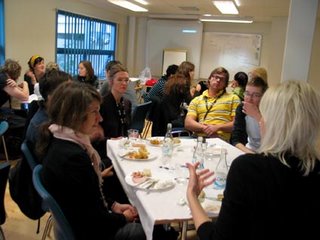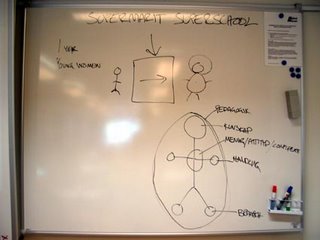EU-project Iperg (started on 1 Sept 2004, has a duration of 42 months. It has a total of ~10MEUR funding from the IST Programme) organised a seminar in Helsinki on 13 December. Pervasive Computing is one of those technical trends that are adduced cyclically. First it was invented by engineers in 1980s, then utilised by artists in 1990s and lastly studied by cultural theorist. At the Iperg seminar the focus was on games and the discussion dwelled from media art to live action role playing (LARP) and using mobile phones as wireless links to pervasive cross media gaming.
Some of you might have followed the discussion of ubiquitous computing at the end of 1990s. Mark Weiser and his multidisciplinary research group from Xerox PARC developed tabs, pads and boards in the 1980s and come up with the term ubiquitous computing (in 1988) when articulating the shift from mainframe computers to PC world and further to situation of one person, many computers. 'It is invisible, everywhere computing that does not live on a personal device of any sort, but is in the woodwork everywhere.' Lately the term pervasive computing has grew into being the generic definition though it is a synonym for ubiquitous computing (&communications). The third related term would be embedded computing where the idea is to embed CPUs to everyday objects from sofas to wallpapers.
But back to the seminar. For me the Iperg event put forward rather conservative visions of pervasive computing/games. I expected to hear something new but instead the researchers talked about the same old same and presented three prototypes: Epidemic Menace (GPS + AR game), Day of the Figurines (SMS game) and Momentum (basically a LARP or did I miss something?).
So what was missing? What is this 'new'? (AKA Some remarks from the event)
How to make simple, enjoyable, gamish experience for an average Joe? What would motivate Joe to join the game? What Joe would play the game? Is a mobile phone really an applicable gaming device? Who would offer these games, whom? How to make a low-tech pervasive game? How pervasive games differ from locative media/games, cross platform gaming (PC <> mobile <> online <> console world is already here)? Why one should be interested in pervasive games?
Currently engineers are into 'users as co-creators of content', 'user centered design' and 'agile methods for project management and development'. I would gladly see these qualities and methods utilised in prototyping (in EU projects in general!). The good thing about Iperg is that there are only a few companies involved. Basically these industry giants (Sony, Nokia) could have a great chance to act as pioneers and utilise the research results commercially. But I quess that will not happen until there are some signs that an average Joe would actually play pervasive games or use WLAN, GPRS, GPS... qualities of their phones. One can never over emphasize the easiness of use and the criticiality of the consumers. Surely lead users, early adopters and enthusiasts exists but in able to really make profit out of pervasive games, the are several challenges to overcome. The value chain is still somewhat unclear as well as the questions of upkeeping such temporal, social and spatial games and making bilions of $ or €. (At the seminar pervasive games were defined to include social, spatial and temporal qualities.)
Jussi Holopainen from NRC was (once again) brilliant and entertaining. He hightlighted the divaricate development of a) pervasive games played with mobile phones (e.g. Botfighters) and b) mobile games with pervasive features (e.g. Hot Potato).
Sabiha Ghellal from Sony Netservices believed the revenues would come from advergames and event-based gaming/services (which btw has been a focus of another EU-project INCCOM). The Iperg-project has not yet developed any such games but they still have one year to go.
We are far from feasible mobile (Java, Brew) games. It is a tough job even for java game developers to generate revenue or at least cover the expences. Iperg game prototypes were funded by EU and it costed A LOT to build them. We talk about ~1 MEUR budget per game here. Of course the development includes a lot of EU bureucracy and research tasks so the budget does not go 100% to the actual development. Despite of that I would say the next challenge is to come up with feasible business models in able to put the research results into practise.






























